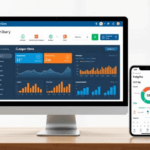In today’s competitive field service industry, companies are grappling with inefficient dispatch processes that lead to delays, miscommunication, and increased operational costs. Traditional methods—relying on manual scheduling and static routing—often fall short in meeting modern demands, leaving organizations struggling to maintain consistent field service responsiveness. This is where real-time dispatch emerges as a game-changing solution, offering agile, data-driven responses that bridge the gap between outdated practices and modern operational excellence.
The core challenge lies in the limitations of conventional dispatch systems. Relying on phone calls and paper-based schedules creates bottlenecks, reduces accountability, and hinders rapid problem resolution. With evolving customer expectations and increasingly dynamic job requirements, companies need a system that enables instant scheduling and live tracking dispatch to monitor their teams continuously. Real-time dispatch leverages advanced technology to address these pain points, ensuring that jobs are assigned immediately and that field teams are accurately tracked from start to finish.
By integrating dynamic job allocation into everyday operations, businesses can automatically distribute work based on technician availability, proximity, and skillset. This not only boosts field service responsiveness but also delivers tangible immediate dispatch benefits—such as reduced response times, optimized routes, and improved customer satisfaction. Moreover, the visibility provided by live tracking dispatch allows managers to make data-driven decisions, further enhancing operational efficiency.
Adopting real-time dispatch transforms the dispatch process from a reactive, cumbersome task into a proactive, streamlined operation. With instant scheduling, live tracking dispatch, and dynamic job allocation working in harmony, organizations are better equipped to meet the challenges of today’s fast-paced environment, ensuring that they reap the full spectrum of immediate dispatch benefits. This blog will explore these innovations in detail, demonstrating how they unlock efficiency and set a new benchmark for field service operations.
Background & Evolution of Field Service Dispatch
The Chaos of Traditional Dispatch
In the past, field service dispatch was largely a manual and error-prone process. Companies relied on telephone calls, handwritten schedules, and paper maps to coordinate field operations. This method of manual scheduling often led to overlapping appointments, inefficient routing, and delays that hurt customer satisfaction. Communication breakdowns were common, and dispatchers struggled to adapt to sudden changes in demand or unforeseen circumstances. These inefficiencies not only increased operational costs but also hindered field service responsiveness. In an environment where every minute mattered, traditional dispatch systems could not keep pace with the dynamic nature of modern service demands.
The Shift to Digital and Real-Time Solutions
Technological advancements have driven a significant shift from outdated methods to digital solutions, ultimately paving the way for real-time dispatch. With the advent of cloud computing, mobile technology, and advanced analytics, organizations can now implement systems that provide instant scheduling and live tracking dispatch capabilities. Real-time dispatch transforms the way jobs are assigned by instantly matching service requests with the nearest available technician. This capability reduces downtime and ensures that resources are allocated more effectively.
The evolution of these systems has also introduced dynamic job allocation, allowing managers to adjust priorities and reassign tasks based on current conditions. As a result, companies experience enhanced field service responsiveness and enjoy immediate dispatch benefits that directly translate to improved customer service. Digital solutions enable dispatchers to monitor operations continuously, ensuring that every service call is handled with precision and speed.
Adopting real-time dispatch not only streamlines scheduling but also integrates instant scheduling with live tracking dispatch to provide complete visibility into field operations. This seamless coordination supports better decision-making and fosters operational agility. In today’s competitive landscape, the shift to digital dispatch systems is essential for organizations looking to optimize performance and deliver rapid, reliable service to their customers.
Understanding Real-Time Dispatch
Defining Real-Time Dispatch
Real-time dispatch refers to an advanced system that allows organizations to assign, monitor, and manage field service tasks as they occur. Unlike traditional dispatch methods that rely on delayed communication and manual updates, real-time dispatch delivers immediate information and enables instant responses. This system plays a crucial role in modern field operations by ensuring that every service request is addressed promptly, reducing downtime and improving overall operational efficiency. With real-time dispatch, companies are better equipped to meet customer demands and adjust to dynamic operational challenges.
Core Technologies Behind It
The backbone of real-time dispatch lies in the integration of several key technologies. Cloud-based solutions provide a scalable and secure platform that supports the seamless sharing of information across multiple devices and locations. Mobile connectivity is another essential element, as it empowers technicians to receive job updates and report progress directly from the field. Additionally, IoT integrations have revolutionized the way data is collected and analyzed, enabling more accurate and up-to-date information on equipment performance and service needs. These technologies collectively support features like instant scheduling and live tracking dispatch, ensuring that tasks are allocated promptly and progress is monitored continuously. By leveraging these innovations, organizations can implement dynamic job allocation systems that automatically assign tasks based on real-time data and technician availability, further enhancing operational performance.
Integration with Field Operations
The true value of real-time dispatch becomes evident when it is integrated into daily field operations. For instance, when a service call comes in, the system facilitates instant scheduling, ensuring that the nearest available technician is alerted immediately. Live tracking dispatch provides managers with the ability to monitor technician locations and job progress in real time, allowing for proactive adjustments and improved decision-making. This seamless integration supports better coordination across teams and contributes significantly to field service responsiveness. Moreover, the ability to execute dynamic job allocation ensures that resources are optimally distributed, even during peak periods. The resulting immediate dispatch benefits include reduced response times, more efficient route planning, and a smoother overall workflow.
By embedding real-time dispatch technology into everyday operations, companies not only modernize their scheduling processes but also set the stage for a more agile and responsive service model. This transformation is critical for businesses aiming to reduce costs, improve customer satisfaction, and maintain a competitive edge. As organizations continue to evolve, real-time dispatch stands out as a pivotal tool that drives both operational efficiency and tangible business outcomes.
Benefits of Instant Scheduling & Live Tracking Dispatch
The Advantage of Instant Scheduling
In traditional dispatch systems, delays caused by manual scheduling often result in wasted time and increased downtime. With instant scheduling, however, every service request is processed immediately. This rapid task assignment means that when a field service call comes in, the system automatically notifies the closest available technician. As a result, technicians spend less time waiting for assignments and more time resolving issues on site. This increased efficiency directly translates into reduced operational costs and improved customer satisfaction. Managers see a marked improvement in productivity, as the need for follow-up communications is minimized. By integrating instant scheduling with real-time dispatch, companies are not only streamlining their workflows but also ensuring that critical jobs are prioritized and handled without delay.
Enhancing Visibility with Live Tracking Dispatch
Another key benefit is the ability to track technicians in real time. Live tracking dispatch provides managers with a comprehensive view of where each technician is at any given moment. This constant visibility empowers decision-makers to reassign tasks on the fly if unexpected delays occur or if priorities shift during the day. With live tracking dispatch, managers can quickly identify bottlenecks and ensure that resources are optimally allocated across various service calls. This transparency helps in reducing response times and enhances field service responsiveness. Customers benefit from more accurate arrival times and real-time updates on service progress, which boosts their confidence in the company’s ability to handle their issues effectively. Moreover, integrating live tracking with a real-time dispatch system means that the entire process becomes more dynamic, enabling more effective route planning and reducing fuel and labor costs.
Real-World Implications
The impact of instant scheduling and live tracking dispatch can be seen in numerous real-world scenarios. For example, consider a medical equipment manufacturer that provides on-site repairs. By utilizing a real-time dispatch system, the company is able to assign technicians instantly when an urgent repair is needed. The system’s instant scheduling feature ensures that the nearest technician is dispatched immediately, reducing the equipment downtime that can have critical consequences in healthcare settings. In another case, a solar panel installation firm might face unpredictable weather conditions or unexpected technical issues during installations. With live tracking dispatch, managers can monitor their teams in real time and dynamically reassign jobs to maintain project timelines and meet customer deadlines.
These improvements collectively provide immediate dispatch benefits that go beyond mere scheduling efficiencies. Companies report significant reductions in response times, leading to better service outcomes and enhanced customer loyalty. When operations are supported by real-time dispatch, the enhanced field service responsiveness helps prevent potential revenue losses caused by delays or miscommunications. In addition, the combination of instant scheduling and live tracking dispatch fosters a culture of accountability and data-driven decision-making. Managers have access to precise metrics that help them optimize workforce allocation and improve overall operational performance.
The benefits of these advanced features are clear. Real-time dispatch systems that incorporate instant scheduling and live tracking dispatch not only streamline operations but also deliver immediate dispatch benefits that are measurable in both time and cost savings. For organizations in industries such as HVAC, home appliances, medical equipment, and solar panel installations, these solutions represent a significant competitive advantage. By addressing longstanding challenges with traditional dispatch methods, businesses are better positioned to meet the demands of today’s fast-paced, customer-centric environment. Ultimately, the transition to these digital tools marks a pivotal step in modernizing field operations and unlocking efficiency across the board.
Optimizing Operations with Dynamic Job Allocation
Explaining Dynamic Job Allocation
Dynamic job allocation is a method that leverages real-time dispatch technology to assign service tasks based on current conditions. Unlike traditional static scheduling, this system evaluates real-time data—such as technician location, skillset, and workload—to determine the best match for each new service request. By automatically matching tasks to the most appropriate field technician, dynamic job allocation minimizes delays and ensures that resources are used efficiently. This approach is a natural extension of real-time dispatch, enabling companies to implement instant scheduling and live tracking dispatch features more effectively. With dynamic job allocation, organizations can quickly adapt to changes and unexpected demands, creating a more agile and responsive field service operation.
Impact on Field Service Responsiveness
The benefits of dynamic job allocation become particularly evident in its impact on field service responsiveness. When service requests are distributed dynamically, response times are significantly reduced. The system continuously updates task assignments based on live data, which allows managers to reassign jobs if conditions change, such as traffic delays or sudden spikes in demand. This flexibility directly improves field service responsiveness by ensuring that the closest and most capable technician is always on the job. In addition, the integration of instant scheduling within real-time dispatch systems means that tasks are assigned immediately, reducing downtime and avoiding the inefficiencies of manual scheduling. Managers also benefit from live tracking dispatch, which provides real-time visibility into technician locations, further enhancing their ability to make data-driven decisions. These improvements culminate in immediate dispatch benefits that not only boost operational efficiency but also elevate customer satisfaction through timely and effective service delivery.
Case Studies or Examples
Consider a scenario faced by a national HVAC service provider that recently integrated dynamic job allocation into its operations. Before implementing the new system, the company relied on manual scheduling, which often resulted in delayed service calls and inefficient route planning. After switching to a real-time dispatch system with dynamic job allocation, the organization experienced a 25% reduction in average response times. Technicians were assigned tasks automatically based on proximity and availability, leading to smoother operations and a noticeable increase in field service responsiveness. The company also saw improvements in customer satisfaction scores, with clients reporting faster service and clearer communication throughout the process.
In another example, a solar panel installation firm used dynamic job allocation to manage its installation and maintenance tasks. With the help of instant scheduling and live tracking dispatch features, the firm was able to reassign jobs dynamically during periods of high demand. When a sudden surge in installation requests occurred on a cloudy day, the system quickly redistributed tasks among available technicians. This flexibility not only prevented service delays but also ensured that each technician was deployed where they were needed most, resulting in a more efficient use of resources. The immediate dispatch benefits of this approach were evident in the firm’s improved operational metrics, including reduced travel time and enhanced overall productivity.
By embedding dynamic job allocation into their real-time dispatch systems, companies across various industries—from medical equipment manufacturers to home appliance service providers—are witnessing transformative changes. The ability to automatically reassign tasks and optimize technician deployment addresses the core challenges of traditional dispatch methods. In today’s competitive environment, enhanced field service responsiveness is not just a metric of efficiency; it is a key driver of customer loyalty and business growth.
The success stories of these organizations underscore the value of integrating dynamic job allocation with modern dispatch solutions. By prioritizing real-time data and responsive scheduling, businesses can achieve significant improvements in operational performance and deliver immediate dispatch benefits that directly impact the bottom line. This strategic shift is essential for companies seeking to remain competitive and responsive in an increasingly demanding market.
Immediate Dispatch Benefits: Real-World Applications
Case Study Overview
Several organizations have already demonstrated the transformative power of real-time dispatch systems. For instance, one leading HVAC service provider integrated a digital dispatch solution that combined instant scheduling with live tracking dispatch. As a result, the company was able to reduce average response times significantly and boost overall customer satisfaction. In another case, a solar panel installation firm implemented dynamic job allocation, allowing it to assign tasks based on real-time technician availability. This led to more efficient route planning and a smoother field operation overall. These success stories highlight how immediate dispatch benefits extend beyond improved scheduling—they drive tangible operational improvements in real-world scenarios.
Quantifiable Benefits
The benefits of adopting a real-time dispatch system are measurable. Companies that have switched from traditional dispatch methods report a reduction in response times by as much as 30 percent. With instant scheduling and live tracking dispatch, managers can monitor progress in real time and reassign tasks when delays occur, ensuring that technicians are always deployed optimally. Data from one medical equipment manufacturer showed that real-time dispatch contributed to a 20 percent increase in service completion rates and a notable boost in field service responsiveness. Additionally, these improvements are reflected in customer feedback, with satisfaction scores rising as immediate dispatch benefits become evident. Quantifiable metrics such as reduced travel times, lower fuel costs, and increased technician productivity all point to the efficiency gains delivered by these systems.
Future Trends
Looking ahead, the evolution of real-time dispatch technology shows no signs of slowing. Emerging innovations, including advanced predictive analytics and artificial intelligence, promise to refine dynamic job allocation even further. Future systems are expected to automatically anticipate service needs based on historical data, weather conditions, and real-time demand fluctuations. As a result, instant scheduling and live tracking dispatch will become even more precise, delivering greater immediate dispatch benefits to field operations. Enhanced connectivity through the Internet of Things will enable even deeper integration between dispatch systems and field equipment, allowing for proactive maintenance and more efficient resource allocation. These trends suggest that organizations adopting real-time dispatch today are laying the groundwork for a future where field service responsiveness is continuously optimized, ensuring that operations remain agile and customer-centric.
In summary, real-time dispatch solutions have already shown significant promise by delivering immediate dispatch benefits that improve operational efficiency and customer satisfaction. The integration of instant scheduling, live tracking dispatch, and dynamic job allocation has led to quantifiable improvements across various industries, from HVAC services to medical equipment and solar panel installations. As technological advancements continue to drive innovation, future trends will further enhance these systems, reinforcing the critical role that real-time dispatch plays in modern field service operations. For companies looking to stay competitive, embracing these technologies is not just an option—it is a strategic imperative that offers clear, measurable benefits now and in the future.
The Path Forward: Shaping Tomorrow’s Dispatch
Real-time dispatch has transformed field service operations, turning what once was a reactive, inefficient process into a streamlined, proactive system. By leveraging instant scheduling, companies are now able to assign tasks immediately, eliminating delays that used to compromise customer satisfaction and increase operational costs. Integrating live tracking dispatch into daily routines further enhances visibility, ensuring that managers have up-to-the-minute data on technician locations and job progress. This combination of technologies not only boosts field service responsiveness but also leads to immediate dispatch benefits that are evident in reduced response times and optimized resource allocation.
Dynamic job allocation plays a critical role in this evolution. Instead of relying on static schedules, real-time dispatch systems now dynamically assign tasks based on current field conditions and technician availability. This flexibility means that when unexpected challenges arise—such as traffic delays or a sudden surge in service requests—the system can quickly reassign jobs, thereby maintaining high levels of efficiency. As a result, organizations across industries from HVAC to medical equipment services are witnessing measurable improvements in both operational performance and customer satisfaction.
Looking ahead, the future potential of real-time dispatch is immense. Emerging trends such as predictive analytics and artificial intelligence promise to further refine instant scheduling and live tracking dispatch, making them even more intuitive and effective. These advancements are expected to enhance dynamic job allocation capabilities, pushing field service responsiveness to new heights. Companies that embrace these technologies will not only enjoy significant immediate dispatch benefits today but will also be well-positioned to capitalize on tomorrow’s innovations.
In summary, real-time dispatch has revolutionized field operations by integrating instant scheduling, live tracking dispatch, dynamic job allocation, and enhanced field service responsiveness. As dispatch technology continues to evolve, its role in driving operational efficiency and customer satisfaction will only grow more critical, setting a new benchmark for the industry in the years to come.
Author Bio

Palani Kumar
Palani Kumar is a seasoned digital marketing professional with over 13 years of experience in crafting impactful strategies for B2B brands.
As the marketing lead at FieldAx, he focuses on bridging the gap between technology and business growth, simplifying complex field service management concepts into valuable insights.
Passionate about delivering informative and practical content, Palani writes about industry trends, best practices, and innovations that help businesses optimize their field operations.
When not working on marketing strategies, he enjoys exploring history, engaging in thought-provoking discussions, and appreciating the balance between technology and tradition.





